Mono-Material Film – Gigafactory 31-05-2023 - Arhive
Mono-Material Film – Gigafactory – Toray Mitsui Chemicals Kumagai
Crude Oil Prices Trend
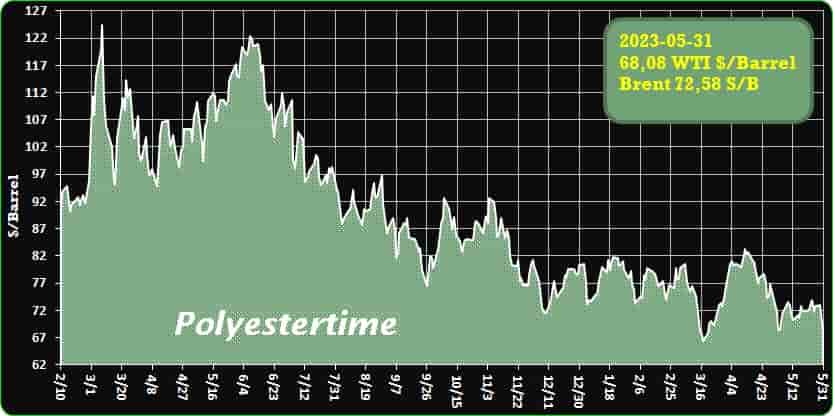
Crude Oil Prices Trend by Polyestertime
-Sidel has successfully converted the PET lines of MenaBev, a PepsiCo bottler based in Jeddah, enabling the company to introduce seven new bottle formats across two PET lines
The Mega plant, one of the largest PepsiCo bottling plants worldwide, spanning 300,000m², serves millions of consumers in the MENA region and is supported by a local distribution center.
Through collaboration with Sidel, MenaBev modified its Combi PET lines to accommodate three new formats for Aquafina, its bottled water product, on one line, and four new formats on the other. MenaBev also sought Sidel’s assistance in creating new formats of the Carolina bottle in response to increased sugar taxes affecting the Saudi market. Despite facing component shortages in the market, both Combi PET lines were adapted within a week.
The Aquafina line now boasts an increased production capacity, capable of running up to 60,000 bottles per hour (bph), compared to its previous rate of 54,000 bph. The Carolina line maintains its speed of 48,000 bph. In an effort to enhance sustainability, the new bottle designs underwent thorough technical development, including feasibility studies, laboratory checks, and performance tests on the stretch blow-molding process. This approach was applied to the 330ml, 500ml, and 1.5L Aquafina bottles, resulting in a lighter-weight 330ml bottle that utilizes 10% less raw materials.
Karim Abdel Wahed, Sidel’s service manager, highlighted the company’s capability to adapt and convert existing Sidel lines, enabling customers like MenaBev to swiftly respond to global changes and market demands. Mono-Material Film – Gigafactory – Toray Mitsui Chemicals Kumagai

Credit : Sidel
-Emerson Enhances Recycling Process for Increased Sustainability in Waste-to-Energy Sector
In the pursuit of a more sustainable waste-to-energy industry, global software and technology leader Emerson is collaborating with Swedish cleantech company HaloSep to optimize their innovative process that transforms hazardous incinerator flue gas residue into usable materials. At HaloSep’s plant for optimization, research, and technology (PORT) in Gothenburg, Sweden, Emerson’s advanced control technology and software are being deployed to manage a cutting-edge chemical separation process. This process effectively recovers valuable salt, metals, and minerals from fly ash, providing an alternative to landfill disposal and significantly improving the sustainability of waste-to-energy operations. Mono-Material Film – Gigafactory – Toray Mitsui Chemicals Kumagai
Recycling materials from challenging waste streams is a crucial step towards achieving a more circular economy. With over 2,600 waste-to-energy plants globally, capable of disposing of approximately 460 million tons of municipal waste each year, the issue of incinerator flue gas residue, known as fly ash, becomes prominent. Fly ash is a hazardous substance containing contaminants like heavy metals, chlorides, and sulfates, and currently, millions of tons of it are transported to landfills via truck, rail, or sea, resulting in significant costs and environmental unsustainability.
HaloSep’s President, Staffan Svensson, explained the importance of their PORT plant: “Given the inconsistent nature of household waste, fly ash resulting from incineration exhibits varying properties that necessitate different separation processes. Our PORT plant will analyze fly ash samples from around the world, test specific separation processes, and showcase the benefits of the circular economy to potential customers. Emerson’s technology and expert guidance in implementing automation throughout the plant have played a pivotal role in optimizing these processes, ultimately enhancing the sustainability of the waste-to-energy sector.”
Emerson’s scalable control system architecture was specially designed and implemented at the PORT facility. Working closely with HaloSep, Emerson developed unique separation sequences that enable the efficient recycling of fly ash with varying compositions. The DeltaV™ distributed control system from Emerson ensures the safe and efficient operation of the separation processes. Additionally, the DeltaV Live software provides operators with high-performance human-machine interfaces, equipped with key performance indicator-led dashboards that offer intuitive reporting, management, and support for optimized decision-making and operational performance.
Nathan Pettus, President of Emerson’s process systems and solutions business, emphasized Emerson’s commitment to driving sustainable innovations that minimize environmental impact in various industries, including plastics, lithium-ion battery manufacturing, and waste-to-energy generation. He stated, “Emerson’s technologies and expertise are designed to handle the complexity of HaloSep’s recycling process, assisting our customers in meeting the growing industrial, processing, and energy demands of today.” Mono-Material Film – Gigafactory – Toray Mitsui Chemicals Kumagai
HaloSep, a subsidiary of the Stena Metall Group, provides an on-plant solution that can be locally constructed at waste-to-energy facilities or deployed at sites where fly ash from smaller plants is consolidated. This approach eliminates the need for long-distance transportation, effectively reducing costs and emissions associated with fly ash management.
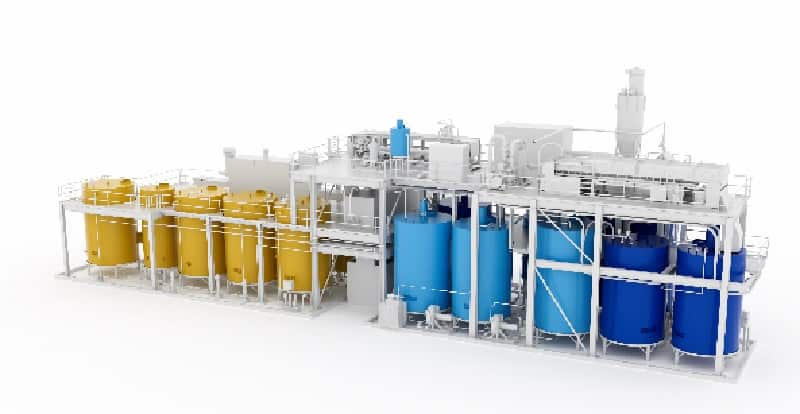
-Toray, Mitsui Chemicals and Kumagai Put People and the Planet First by Jointly Developing Revolutionary Mono-Material Film Packaging Material and Technology
Toray Industries, Inc., Mitsui Chemicals, Inc., and Kumagai Co., Ltd., announced today that they have jointly developed a revolutionary mono-material film packaging material and manufacturing process that are free of volatile organic compounds (VOCs; see note). Carbon dioxide emissions are 80% lower than from conventional counterparts with this new material, which is also recyclable.
The lightness, transparency, and processing ease of these materials should make them popular choices for refillable pouch applications, including for foods, shampoos, and detergents. The market for these materials should keep growing more than 3% annually (see note 2) as the global population rises. Mono-Material Film – Gigafactory – Toray Mitsui Chemicals Kumagai
Regular film packaging material manufacturing uses petroleum solvents inks to print text, images, and other information on plastic films and in adhesives to laminate plastic films. These solvents release VOCs. The equipment required to heat, dry, and incinerate petroleum solvents in inks and adhesives consumes a lot of electricity. The lamination of plastic films with different materials to achieve various functions makes them hard to recycle, leading to their frequent incineration as waste.
VOC emissions from petroleum solvents in film packaging materials production have raised concerns about their impact on work environments. Another issue is the global warming impact of carbon dioxide emissions from their electricity consumption in production processes and from incineration during disposal.
These considerations prompted Toray, Mitsui Chemicals, and Kumagai to develop a mono-material film packaging material and manufacturing technology that is free of petroleum solvents for ink and adhesives and is recyclable.
Toray demonstrated printing for the new material’s manufacturing process by employing its Toray proprietary IMPRIMA (see note 3) offset printing plate. The plate uses electron beam-cured printing inks that consumer less electricity need no thermal drying. Mitsui Chemicals verified the lamination process with adhesives that do not incorporate petroleum solvents. The manufacturing process is thus VOC-free because it does not use petroleum solvents for inks or adhesives. Mono-Material Film – Gigafactory – Toray Mitsui Chemicals Kumagai
Incorporating Kumagai’s package manufacturing and processing technologies resulted in a mono-material film packaging material. This breakthrough makes the material far easier to recycle than regular counterparts.
Under this collaboration, Toray is leading the way with its printing technology. Mitsui Chemicals is providing total coordination for the new setup with its materials technology. Kumagai is leveraging its industry-leading package manufacturing technology. The three look to commercialize the new film packaging material for food and other daily necessities.
They will offer the material to distributors and brand owners to help alleviate the environmental impact of the film packaging industry and contribute to a sustainable economy.
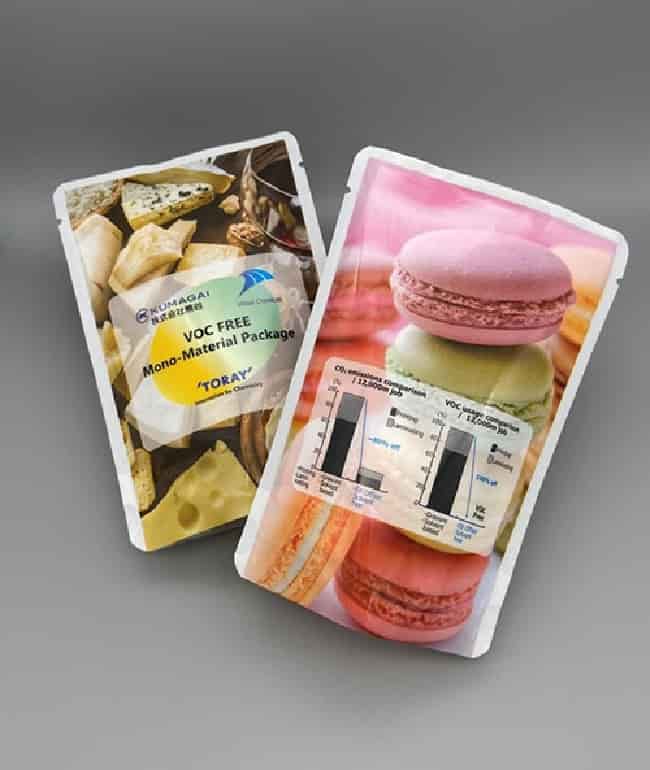
-Stellantis inaugurates the first gigafactory in France: «European champion of electric batteries»
In Douvrin, in north-eastern France, the first European gigafactory for the production of batteries for electric cars was inaugurated. The plant starts with an annual production of 13.4 GWh and by 2030 will produce 40 GWh per year. The site is spread over 34 hectares and will be divided into three blocks, the first of which starts today, 30 May 2023. By 2030 it is expected to employ around 2,000 people. Mono-Material Film – Gigafactory – Toray Mitsui Chemicals Kumagai
Investments of over 7 billion
“Here we are in the future.” So John Elkann, president of Stellantis, on the sidelines of the inauguration of the plant built by Acc, the joint venture between Stellantis, Mercedes-Benz and TotalEnergies in Douvrin, in northeastern France. “It’s a big European project,” added Elkann, referring to the fact that this is only the first of three gigafactories that Acc will build in Europe. The second will be in Germany and the third in Italy, in Termoli, for a total investment of 7.3 billion euros, of which about 1.3 billion in public investments.
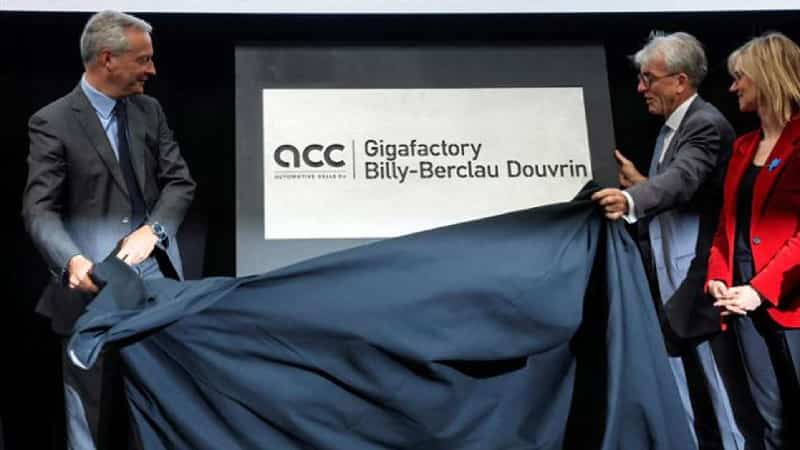
-Biopolymers producers sign MOU to advance PHA/PLA solutions in China
Bluepha, TotalEnergies Corbion to collaborate on high-performance biopolymer development
Bluepha Co. Ltd, a China-based synthetic biology company in China, and Netherlands-headquartered PLA producer TotalEnergies Corbion, have signed a memorandum of understanding aimed at fostering the market adoption of PLA/PHA-based solutions in China.
The companies will focus on the development of new high-performance PHA/PLA blends based on Bluepha’s PHA with TotalEnergies Corbion’s Luminy PLA technology.
Calling TotalEnergies Corbion a ‘trustworthy partner’, Teng Li, president and co-founder of Bluepha used a Chinese saying to characterise the collaboration, describing it as ‘Adding wings to the tiger’. Mono-Material Film – Gigafactory – Toray Mitsui Chemicals Kumagai
“By combining the complement ary properties of these materials, we will significantly expand the application possibilities for brand owners seeking fully biobased material solutions,” said Thomas Philipon, CEO of TotalEnergies Corbion.
Bluepha completed construction of its first industrial-scale production facility, called BioFAB1, in 2022 in Yancheng and launched its first portfolio of marine degradable biopolymers during a celebration held this year on 1 March.
Before the MOU signing ceremony, Thomas Philipon was taken on a tour of the new Bluepha PHA Biorefinery.
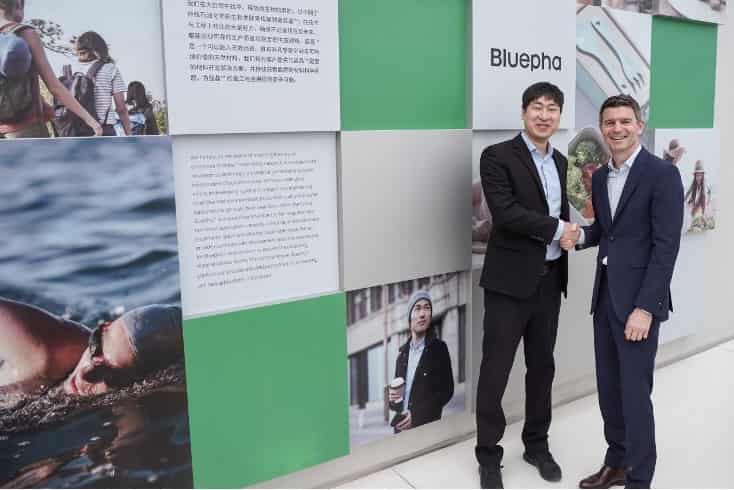
-Avient Establishes First Production Line for Long-Fiber Composites in Asia Pacific
Avient, a compounder specializing in engineered materials, has recently introduced its inaugural production line for Complēt and OnForce long-fiber-reinforced thermoplastic composites in the Asia Pacific region. The new production line has been installed at Avient’s regional headquarters in Shanghai to cater to the growing demand for composite materials across various industries such as transportation, power tools, sports equipment, furniture, and outdoor recreation. These composites possess exceptional impact strength, elastic modulus, and material strength, making them an ideal choice for applications requiring robust performance. Mono-Material Film – Gigafactory – Toray Mitsui Chemicals Kumagai
Flight Xu, the General Manager of Specialty Engineered Materials Asia at Avient, highlights the shifting trend in the composites market from traditional materials like aluminum alloy and steel to long-fiber composites. As a result, there is a rising demand for an integrated approach encompassing material formulation, component design, and forming processes. Avient’s new production line, combined with their engineering support and design for manufacturability services offered through Avient Design, provides local customers with an efficient and flexible setup, enabling them to accelerate their time to market and gain a competitive edge.
The Complēt and OnForce composites offer structural characteristics that deliver excellent stiffness, strength, and toughness, positioning them as viable alternatives to metals. Moreover, the use of these composites as a replacement for metal components facilitates substantial weight reduction, along with the time and cost-saving benefits of single-step injection molding.
Avient also emphasizes the expertise of their specialized industrial designers and project engineers at Avient Design, who possess extensive knowledge in materials and molding. This enables them to provide valuable insights to customers regarding design and materials, enabling the launch of innovative products that meet the evolving requirements of the industry. Mono-Material Film – Gigafactory – Toray Mitsui Chemicals Kumagai
In addition, Avient offers the flexibility to tailor the Complēt and OnForce formulations to meet specific application requirements. By utilizing a range of engineering resins such as polypropylene (PP), acrylonitrile-butadiene-styrene (ABS), polyphenylene sulfide (PPS), and polyphthalamide (PPA), Avient can cater to the diverse needs of customers in sectors like power tools, sports equipment, utility vehicles, furniture, and outdoor recreation.

-Plastics treaty talks to resume underpinned by diverging interests
Countries are set to gather in Paris to continue negotiations on a plastics treaty as campaigners warn about attempts from industry to derail the talks.
Talks on a new treaty to keep the world from drowning in plastics are heading for another round in Paris between Monday and Friday, following a historic decision in 2022 between countries to negotiate a legally binding agreement by the end of 2024.
Plastics have permeated every aspect of society, leading to nefarious consequences for the environment and human health. Countries agreed to hammer out a treaty to tackle the plastic crisis together. In Geneva, where some of the preparatory meetings have taken place over the last year, environmental campaigners and other delegates warn about intentions to weaken the agreement. Mono-Material Film – Gigafactory – Toray Mitsui Chemicals Kumagai
After a first round of negotiations held in December in Uruguay, countries are hoping this week will pave the way for an early draft of the treaty to be readied ahead of the next round of talks, due to take place in Kenya in November 2023. After that, they will have one year to figure out the nitty-gritty details and adopt the deal.
“Time for negotiations is short, but this should not lead us to settle for a weak agreement,” Peruvian ambassador Gustavo Meza-Cuadra, chair of the body tasked with drafting the treaty, said by video message at a briefing for diplomats and civil society in Geneva late last month.
Closing the plastic tap or what?
The secretariat coordinating discussions issued a document in April summing up the different proposals countries have made to be considered for the treaty. The document shows a mix of options ranging from obligations, to control measures, to voluntary commitments. Mono-Material Film – Gigafactory – Toray Mitsui Chemicals Kumagai
Among the possibilities is for the treaty to set Paris-like targets for the globe similar to those agreed in the 2015 Climate Accord, as well as national ones. But civil society groups are worried about the prevalence of voluntary measures.
In an analysis shared with the media, the Center for International Environmental Law (CIEL) wrote that the secretariat’s paper “troublingly displays lesser ambition than Member States’ submissions, weakens calls for legally-binding measures by turning them into voluntary ones, and borrows from submissions by heavy-polluting countries such as China”.
One key issue will be whether to set targets to phase out or reduce production of new plastics. The world produces around 440 million tonnes of plastic every year and is on the path to triple by 2060, according to the OECD.
“Scientifically proven necessities for the treaty include upstream measures like a cap on production and phasing out of problematic chemicals in plastics,” Bethany Carney, professor at Gothenburg University and member of the steering committee of the Scientists’ Coalition for an Effective Plastics Treaty, said at the briefing.
A group of 55 countries, including European Union members, working together to push for an ambitious treaty are in favour of imposing bans and restrictions on the production and consumption of problematic plastics, such as single-use plastics, but also to prevent plastic waste from leaking into the environment. Mono-Material Film – Gigafactory – Toray Mitsui Chemicals Kumagai
In contrast, the United States, Saudi Arabia and Russia, where the petrochemical industry wields great influence, have led efforts to have a climate-like agreement relying on the voluntary efforts of each country rather than on a strict global set of rules.
Private interests at play
Civil society has warned about previous attempts by the petrochemical sector to keep the treaty from imposing any limitations on plastic production. With the projected ramp-up for renewable energy and electric cars, the oil and gas industry is banking on plastics, which are mostly made from fossil fuels.
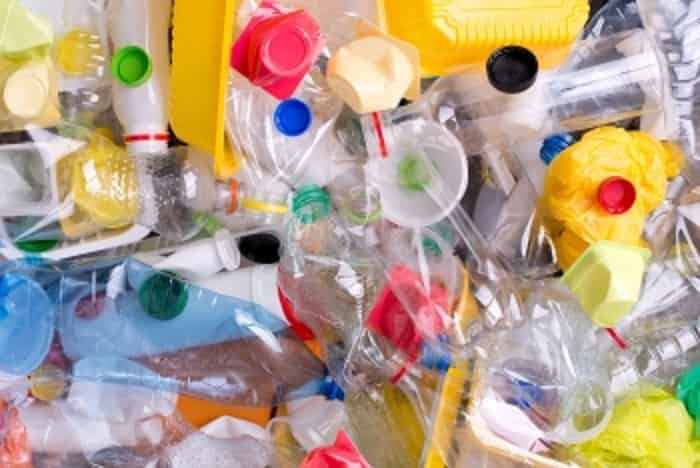
-INDA releases North American Nonwoven Materials Annual Study
The Study Offers the Nonwovens Industry Key Metrics to Assist in Strategic Planning and Investments
INDA, the Association of the Nonwovens Fabrics Industry, announces the publication of a new study, North American Nonwoven Materials Annual Study 2022.
Based on actual surveys and interviews with producers, enhancing the accuracy and relevance, this study tracks machine additions, closures, and productivity improvements. This study is the industry benchmark for capacity and production information for North America and the only publication that provides an estimate of operating rates, based on nameplate machine capacity, through the year 2022. The 72-page study contains 43 figures and 11 tables. Mono-Material Film – Gigafactory – Toray Mitsui Chemicals Kumagai
“An element of INDA’s mission is to provide credible statistics to the nonwovens and engineered materials industry,” said Tony Fragnito, INDA President. “Our objective is to continually improve the quality of data and industry information. We feel the industry will greatly benefit from this in-depth resource for strategic planning and investment purposes,” Fragnito added.
The complete study is provided to producers who supplied key metrics. The Executive Summary, an overview of the findings and implications, will be offered to current INDA members on a complimentary basis. The detailed study is available for purchase, with members receiving a discount. Findings from this year’s study include:
North American capacity continues to increase with investments being made across all the processes and for a variety of end-uses. The industry’s nameplate capacity utilization has increased year-over-year, for the fifth consecutive year.
In 2022, capacity of nonwovens in North America reached 5.565 million tonnes, an increase from the previous year of 2.4% (net growth of 128,700 tonnes) and an improvement over the previous year’s growth rate of 1.8%.
North American imports, in tonnage, decreased 24.3% in 2022 and exports decreased 16.3% due to market stabilization after COVID. Nonwoven production tends to stay within the region, so the net trade balance (imports less exports) accounted for less than 5.5% of the region’s capacity. Mono-Material Film – Gigafactory – Toray Mitsui Chemicals Kumagai
“2022 was a period of economic adjustment and stabilization,” said Mark Snider, Chief Market & Industry Analyst. “We’re seeing a controlled and consistent transition back to pre-pandemic levels of nonwoven growth.”

-PETG vs TPU: The Differences Simply Explained
Take a look at how PETG vs TPU filaments compare, and discover which one is right for your next 3D printing project!
electing the right filament for your 3D printer can be a daunting task, as there are so many options available. Two widely used filaments are PETG and TPU. Both materials offer unique benefits and drawbacks. PETG is a popular choice known for its strength and durability. On the other hand, TPU is valued for its flexibility and impact resistance.
To give you a clearer idea of the differences between these two materials, imagine a 3D printed storage container made of PETG.
The container is strong, rigid, and capable of withstanding external force. In contrast, picture a 3D printed shoe sole made of TPU. It’s flexible, providing comfortable movement and impact resistance. Mono-Material Film – Gigafactory – Toray Mitsui Chemicals Kumagai
In this article, we’ll provide an in-depth comparison of PETG and TPU filaments, highlighting their printing performance, mechcanical properties, and other essential factors to consider when choosing between them. With this in mind, let’s dive in!
Let’s take a closer look at the two different materials and explore their basic attributes.
PETG
Polyethylene terephthalate glycol-modified (PETG) is a thermoplastic polymer known for its chemical resistance, strength, and transparent qualities. It’s primarily sourced from crude oil, and the chemical components – glycol and terephthalic acid – are then heated and mixed to form raw PETG plastic.
PETG has grown in popularity in the 3D printing space due to its durability and strength. PETG filaments are popular for making a variety of 3D printed objects, such as mechanical parts, figurines, toys, and common household items. Its high impact strength and resistance to high temperatures, UV rays, water, and chemical solvents make it an excellent choice for printing parts that will be subjected to frequent wear and tear.
PETG can be more challenging to print than other materials like PLA, as it requires high temperatures and is prone to over-adhesion and stringing. However, it remains a versatile filament that can be used for many different applications.
Thermoplastic polyurethane (TPU), is a flexible rubber-like material with excellent impact resistance, durability, and elasticity. It’s made by combining a polyol with a diisocyanate through a process called polymerization. Mono-Material Film – Gigafactory – Toray Mitsui Chemicals Kumagai
TPU is often derived from petroleum-based sources but can also be made from renewable sources such as plants or waste biomass. The production method can vary depending on the manufacturer and their specific processes. It’s commonly used for creating flexible parts such as phone cases, shoe soles, and certain automotive parts. Its main advantages include flexibility and resistance to impact and abrasion. TPU also has excellent layer adhesion and can produce highly detailed prints.

